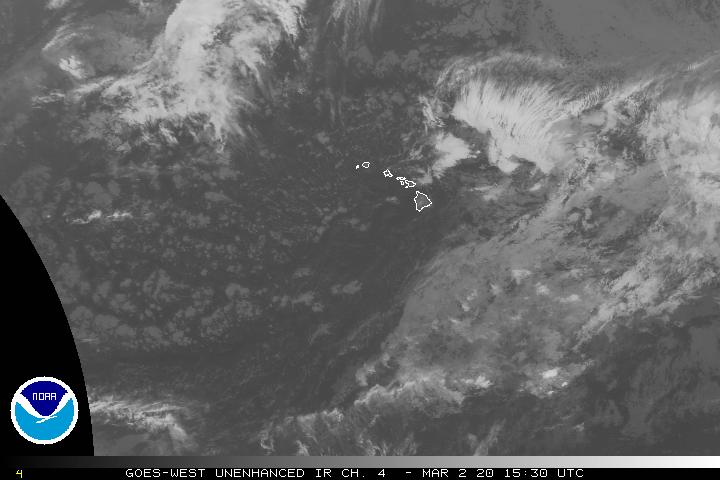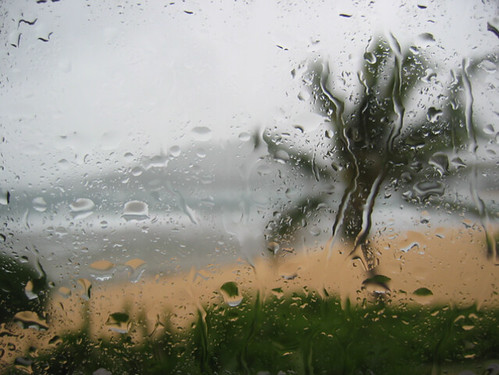Air Temperatures – The following maximum temperatures (F) were recorded across the state of Hawaii Tuesday…along with the minimums Tuesday:
79 – 66 Lihue, Kauai
88 – 71 Honolulu, Oahu
84 – 63 Molokai AP
86 – 64 Kahului AP, Maui
85 – 75 Kailua Kona
87 – 66 Hilo AP, Hawaii
Here are the latest 24-hour precipitation totals (inches) for each of the islands…as of Tuesday:
2.96 Kokee, Kauai
0.69 Moanalua RG, Oahu
0.01 Molokai
0.00 Lanai
0.00 Kahoolawe
0.01 Kula Branch Station, Maui
0.67 Kealakekua, Big Island
The following numbers represent the strongest wind gusts (mph)…as of Tuesday:
36 Barking Sands, Kauai – NE
35 Kuaokala, Oahu – NNE
28 Molokai
28 Lanai
22 Kahoolawe
21 Kapalua, Maui
23 PTA Range 17, Big Island
Hawaii’s Mountains – Here’s a link to the live web cam on the summit of near 13,800 foot Mauna Kea on the Big Island of Hawaii. This web cam is available during the daylight hours here in the islands…and when there’s a big moon shining down during the night at times. Plus, during the nights you will be able to see stars, and the sunrise and sunset too…depending upon weather conditions.
Aloha Paragraphs

Low pressure system over the ocean to the north…with
its fragmenting cold front moving into the state

Cold front has reached Kauai…soon to be
over Oahu, heading southeast

Clear to partly cloudy across the state…cloudy areas

Showers falling locally…locally generous – looping radar image
Small Craft Advisory…most coasts and channels
Gale Warning…Alenuihaha and Pailolo channels,
Maalaea Bay and portions of leeward Maui waters
Wind Advisory…Lanai through Wednesday 6pm
~~~ Hawaii Weather Narrative ~~~
Cooler northerly breezes moving into the state…in the wake of a cold front. Here’s the latest weather map, showing the Hawaiian Islands, and the rest of the North Pacific Ocean. We find high pressure systems far to the northeast and northwest of Hawaii…with an associated ridge over Kauai. At the same time, we see low pressure systems north of the islands…along with a cold front moving through the state. The forecast shows stronger and gusty north winds arriving in the wake of the frontal passage for a couple of days. This in turn will keep cooler than normal weather over the state. The winds will gradually become more common trade winds, before calming down Friday into the weekend. The trade winds should return later this coming weekend into early next week.
Here’s a wind profile…of the offshore waters around the islands – with a closer view
Here’s the Hawaiian Islands Sulfate Aerosol…animated graphic – showing vog forecast
Showers from a cold front moving through the state…a few heavy downpours locally. This front will likely deliver light to moderately heavy showers…although with a few on the more generous side. It’s moved over Kauai and Oahu, then Maui County tonight, before stalling over or around the Big Island Wednesday. The gusty winds following in the wake of the front will carry frequent windward showers our way, which will stretch over into the leeward sides on the smaller islands at times locally. These winds, and their associated showers should remain active through Thursday, before the winds ease up Friday into the first part of the weekend. These lighter winds will cause afternoon clouds with localized upcountry showers Saturday and Sunday.
Marine environment details: Strengthening north to northeast winds will result in small craft advisory conditions over most coastal waters over the next few days. Winds may get strong enough across the Alenuihaha channel to require a gale warning on Wednesday thus a gale watch has been issued for that zone.
A short period north northwest swell will fill in tonight and Wednesday before slowly subsiding Thursday and Friday. A small northwest swell is expected to fill in on Saturday with a larger reinforcement expected to arrive on Sunday. Short period choppy surf will increase over the next few days due to the strengthening trade winds. There will also be a series of small south swells throughout the forecast period.

Stronger and gusty winds…small to medium surf
World-wide tropical cyclone activity:
>>> Atlantic Ocean: The last regularly scheduled Tropical Weather Outlook of the 2015 Atlantic hurricane season…has occurred. Routine issuance of the Tropical Weather Outlook will resume on June 1, 2016. During the off-season, Special Tropical Weather Outlooks will be issued if conditions warrant. Here’s the 2015 hurricane season summary
Here’s a satellite image of the Atlantic Ocean
>>> Caribbean Sea: The last regularly scheduled Tropical Weather Outlook of the 2015 Atlantic hurricane season…has occurred. Routine issuance of the Tropical Weather Outlook will resume on June 1, 2016. During the off-season, Special Tropical Weather Outlooks will be issued if conditions warrant.
>>> Gulf of Mexico: The last regularly scheduled Tropical Weather Outlook of the 2015 Atlantic hurricane season…has occurred. Routine issuance of the Tropical Weather Outlook will resume on June 1, 2016. During the off-season, Special Tropical Weather Outlooks will be issued if conditions warrant.
Here’s a satellite image of the Caribbean Sea…and the Gulf of Mexico
Here’s the link to the National Hurricane Center (NHC)
>>> Eastern Pacific: The last regularly scheduled Tropical Weather Outlook of the 2015 North Pacific hurricane season…has occurred. Routine issuance of the Tropical Weather Outlook will resume on May 15, 2016. During the off-season, Special Tropical Weather Outlooks will be issued if conditions warrant. Here’s the 2015 hurricane season summary
Here’s a wide satellite image that covers the entire area between Mexico, out through the central Pacific…to the International Dateline.
Here’s the link to the National Hurricane Center (NHC)
>>> Central Pacific: The central north Pacific hurricane season has officially ended. Routine issuance of the tropical weather outlook will resume on June 1, 2016. During the off-season, special tropical weather outlooks will be issued if conditions warrant. Here’s the 2015 hurricane season summary
Here’s a link to the Central Pacific Hurricane Center (CPHC)
>>> South Pacific Ocean:
Tropical Cyclone 18P (Zena) is active in the southwest Pacific, here’s the JTWC graphical track map, a satellite image, and what the computer forecast models are showing of this strengthening storm.
>>> North and South Indian Oceans / Arabian Sea: No active tropical cyclones
Here’s a link to the Joint Typhoon Warning Center (JTWC)
Interesting: Scotland shuts down its last coal-fired electric power plant – After nearly 50 years of service, Scotland’s last coal-fired power plant — Longannet Power Station — has finally gone offline, putting an end to over 100 years of burning coal for electricity.
It’s an important moment for Scottish Power, which looks ahead to clean power initiatives with the goal of going all-renewable by 2020,
But it’s also a very symbolic action for the world. Hopefully other nations will follow suit, creating a domino effect as country by country eliminates its coal plants — like the one above — in favor of renewable alternatives.
Brought online in 1969, Longannet was only designed to be used for 25 years. The plant had four generating units producing 2,400 megawatts at maximum capacity — enough to power 25 percent of Scottish homes.
When Longannet was initially constructed, it was the largest coal-fired plant in Europe. It remained a critical element of Scotland’s energy plan — one reason why it took so long to decommission. Scottish Power had to move carefully to ensure that they didn’t jeopardize the power supply during the transition.
Over its lifetime, the plant generated 400 terrawatt hours worth of electricity, used four million tons of coal annually and ran for 918,315 hours in total. The shutoff of the final generating unit marked the end of an era.
It was a very timely end. Longannet’s size has since been supplanted. At the time of its closure, it was the third-largest coal plant in Europe.
But it was also one of the United Kingdom’s biggest polluters. Changing policies on carbon pollution made the plant extremely expensive to operate, between routine maintenance, retrofits and carbon fines – and forced Scottish Power to take it offline.
The ultimate unsustainability of the plant serves as an excellent illustration of why aggressive carbon emission regulation works — it forced Scotland’s hand much sooner than a call for renewable energy could have ever done. Sometimes, it’s necessary to appeal to base economic realities rather than principles.
Some engineers caution that the closure could be a costly experiment. They argue that because the plant generated such a huge segment of the country’s power supply, taking it offline could create instability on the electrical grid.
Scottish Power has clearly planned ahead and feels otherwise. If the company can successfully balance the electrical needs of the country, it could provide a blueprint for other nations considering the elimination of coal power.
Taking the clean energy plunge might feel intimidating until nations see someone else take the lead. And that makes Scotland’s highly progressive move very important.
Over 200 people worked at the power plant, and up to 1,000 jobs related to Longannet may also be at risk with the closure.
Scottish Power explains that it has been working closely with employees to offer them placements elsewhere in the country, provide them with retirement options or facilitate transitions to other careers. A skeleton crew will also be remaining behind at the plant during the decommissioning phase.
Meanwhile, Scottish Power has major wave and solar projects in the works, and they’ll require workers familiar with the electricity generation industry and its auxiliary needs.
Today, Scotland, tomorrow, the world?












 Email Glenn James:
Email Glenn James:
Peggy Says:
Enjoyed reading about Scotland’s shut down of its last coal fired plant. Hope the world follows its example. Interesting that Scotland has wave energy projects planned. There is a lot of power in our waves here, as anyone who has been swimming or surfing on the north shore in the winter can feel.
~~~ Hi Peggy, good to hear from you again. It is an interesting article, I agree. Yes indeed, let’s hope that the world gets its act together!
What you say is so true, there’s a whole lot of energy in the ocean, all over the world…and especially along our north shores during the winter months!
Aloha, Glenn